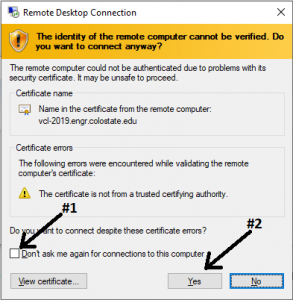The Engineering Virtual Classroom is a way for you to gain access to most of the Engineering software from a remote location. By using this tool you will be able to do homework or projects from your home or dorm room.
Connecting to the Virtual Classroom
To access the Virtual Classroom you will need up to three applications: a client for a VPN connection, Duo, and a Remote Desktop Client (or RDP client).
1. (If Off-Campus) Connect to CSU's Virtual Private Network (VPN)
If you are off-campus, you will first need to create a secure VPN connection to CSU.
2. Install a Remote Desktop (RDP) Client.
Windows
We recommend using the default Remote Desktop client that is built into Windows.
Mac OSX
Go to the App Store and search for “Microsoft Remote Desktop”. Install this on your system.

Note: Do NOT use the old version (version 2.1.1) that comes with Microsoft Office as it does not work properly.
LInux
Install and use Remmina and the Remmina RDP plugin (remmina-plugin-rdp) or a command line utility like FreeRDP using your package management system.
Note: Do NOT use rdesktop as it is not able to connect properly.
3. Set up and Start the Connection
Windows
- Download the connection file
- Double click the downloaded file.
- When you get a warning similar to the image example below, check the “Don’t ask me again….” option

- Login using your Engineering username and password. For your username please format it as follows: “engr.colostate.edu\username“
Mac OSX
- Download the connection file
- Double click the downloaded file, and ignore any certificate warnings.
- Move the .rdp file to your desktop for future use (it’s typically downloaded to your Downloads folder)
- Login using your Engineering username and password. For your username please format it as follows: “engr.colostate.edu\username“
Linux
- The server name is vcl.engr.colostate.edu
- Use your Engineering username and password.
- Accept the certificates.
Policies
Please read this section carefully! You may be denied access to the Virtual Classroom if you fail to abide by these policies. The general Labs policies also apply.
- This resource is primarily intended for academic purposes. There are excellent options for research computing within the College as well.
- Do not use the Virtual Classroom for running processes that consume an excessive amount of CPU or RAM.
NOTE – Minor impact on system performance: Greater than 30% after 60 minutes you will receive a warning via e-mail. If you have an active session, a pop-up warning will be sent.
Severe impact on server performance: Greater than 40% for greater than 15 minutes, process will be terminated immediately. If you will be running processes with this kind of impact, please contact us so we can help you find a better resource for your work. - You may not use this resource outside of the United States.
- Due to the scarcity of session licenses, any Virtual Classroom session that is idle for over 3 hours will be automatically logged off so that others can use this resource.
- Engineering students have access to the Virtual Classroom. By default, faculty and staff do not. Faculty and staff may pay an annual fee to access the Virtual Classroom for course-related purposes; please contact ETS for details.
- Please do not consider the Virtual Classroom a purely distance education tool, or a substitute for the physical computer labs. The Virtual Classroom is meant to be used as a convenient supplement to the physical computer labs. It is a student-funded project and thus only students have access.
Many of the restrictions above are based upon licensing restrictions from the software companies, which we must agree to in order to use their software.
Frequently Asked Questions (FAQ)
- How do I keep the Virtual Classroom window from using both my monitors?
Right click on the RDP file you downloaded to access the Virtual Classroom, select edit, and go to the Display tab. Uncheck the “Use all my monitors …” option. Then go to the General tab and click save.
- There’s another setting I want to change, such as …?
Right click on the RDP file you downloaded to access the Virtual Classroom, and select edit. You will see all the user configurable options in the various tabs. To make your changes permanent, go to the General tab and click save. - What do I need to manually configure the RDP connection
The server name isvcl.engr.colostate.edu.
When logging in, you should specify your username in the format of engr.colostate.edu\username. - When I log in my screen goes black or green and I can’t do anything.
Your remote session is stuck trying to log in and will unlock in 2 hours (do not try to log in until the 2 hours has passed or the 2 hour clock will start over). Please call ETS or contact us via Freshservice for support during normal business hours. - Experiencing screen resolution issues?
Make sure the screen resolution is set the same on both your computer and the Remote Desktop connection app.
Be advised some RDP clients do not work well or at all. Some examples would be the old RDP client supplied with the Mac version of Microsoft Office, or the rdesktop application on Linux.
